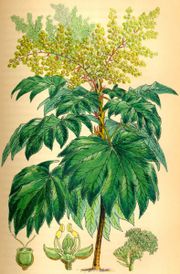Tetrapanax papyrifer
| Tetrapanax papyrifer subsp. var. | Rice-paper Plant | |||||||||||||||||||||||||||||||||||||||||||||||||||||||
|---|---|---|---|---|---|---|---|---|---|---|---|---|---|---|---|---|---|---|---|---|---|---|---|---|---|---|---|---|---|---|---|---|---|---|---|---|---|---|---|---|---|---|---|---|---|---|---|---|---|---|---|---|---|---|---|---|

|
|
| ||||||||||||||||||||||||||||||||||||||||||||||||||||||
| ||||||||||||||||||||||||||||||||||||||||||||||||||||||||
Tetrapanax papyrifer {{{latin_name}}}
|
'
| ||||||||||||||||||||||||||||||||||||||||
|---|---|---|---|---|---|---|---|---|---|---|---|---|---|---|---|---|---|---|---|---|---|---|---|---|---|---|---|---|---|---|---|---|---|---|---|---|---|---|---|---|---|

|
|
| |||||||||||||||||||||||||||||||||||||||
| |||||||||||||||||||||||||||||||||||||||||
Tetrapanax papyrifer (Tung-tsau or Rice-paper Plant) is an evergreen shrub in the family Araliaceae, the sole species in the genus Tetrapanaxwp.
| Standard Cyclopedia of Horticulture |
|---|
|
Tetrapanax (four and panax, referring to the four-merous flower structure). Araliaceae. By Bentham & Hooker (Genera Plantarum) this genus is included in Fatsia, and is so treated in Vol. III, page 1204. By others, however, it is kept distinct, and the plant known as Fatsia papyrifera then becomes T. papyriferum, Koch, the only species. The reader may take his choice whether to name the plant in one genus or the other; the preference probably lies with placing it in Tetrapanax. This genus, if accepted, differs from Fatsia in its four-merous rather than mostly five-merous flowers, with two-merous ovary, the tomentose-lanate character, and other features. T. papyriferum is an excellent subtropical subject. Fatsia japonica, Decne. & Planch., remains in that genus, as treated on page 1204. CH
|
| Standard Cyclopedia of Horticulture |
|---|
|
Fatsia papyrifera, Benth. & Hook. (Aralia papyrifera, Hook. Tetrapanax papyriferum, Koch.). Height 5-7ft. (according to Franceschi, 20 ft. in the open ground in S. Calif.): branches and young lvs. covered with stellate, more or less deciduous down: mature lvs. reaching 1 ft. long, cordate, 5-7-lobed; lobes acute, serrate; sinus very deep :fls. inconspicuous,white, in sessile,globose clusters. CH
|
Cultivation
- Do you have cultivation info on this plant? Edit this section!
Propagation
- Do you have propagation info on this plant? Edit this section!
Pests and diseases
- Do you have pest and disease info on this plant? Edit this section!
Species
Gallery
If you have a photo of this plant, please upload it! Plus, there may be other photos available for you to add.
-
photo 1
-
photo 2
-
photo 3
References
- Standard Cyclopedia of Horticulture, by L. H. Bailey, MacMillan Co., 1963
External links
- w:Tetrapanax papyrifer. Some of the material on this page may be from Wikipedia, under the Creative Commons license.
- Tetrapanax papyrifer QR Code (Size 50, 100, 200, 500)
